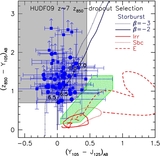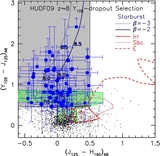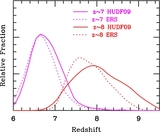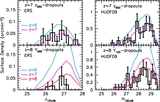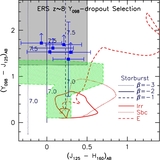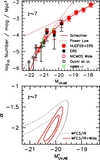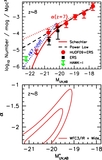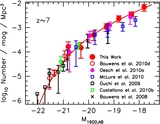Image Details
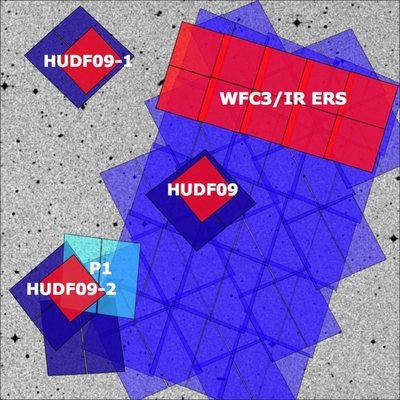
Caption: Figure 1.
Deep WFC3/IR data over the extended CDF-South GOODS field used to search for
z
![]() 7 LBGs. The red rectangles over the HUDF, HUDF05-1 (P12), and HUDF05-2 (P34) fields (labeled HUDF09, HUDF09-1, and HUDF09-2)
show the position of the three ~4.7 arcmin
2 ultra-deep WFC3/IR observations (~29–29.5 AB mag at 5σ) that make up the HUDF09 program (Section 2.1). The upper ten rectangles
show the WFC3/IR pointings that make up the ERS observations (GO 11359; PI: O'Connell) and cover ~40 arcmin
2 (Section 2.2). The dark blue regions show the position of the ultra-deep 100 +-orbit ACS/WFC data over the HUDF (Beckwith
et al. 2006) and HUDF05-1/HUDF05-2 (P12, P34: Oesch et al. 2009) fields, while the blue regions show the position of the ACS
observations over the GOODS fields (Giavalisco et al. 2004). The cyan region labeled P1 shows the position of the deep 111-orbit
ACS observations we obtained over the HUDF09-2 WFC3/IR field while observing the HUDF09 field with the WFC3/IR camera. A convenient
summary of the properties of these search fields is given in Table 1.
7 LBGs. The red rectangles over the HUDF, HUDF05-1 (P12), and HUDF05-2 (P34) fields (labeled HUDF09, HUDF09-1, and HUDF09-2)
show the position of the three ~4.7 arcmin
2 ultra-deep WFC3/IR observations (~29–29.5 AB mag at 5σ) that make up the HUDF09 program (Section 2.1). The upper ten rectangles
show the WFC3/IR pointings that make up the ERS observations (GO 11359; PI: O'Connell) and cover ~40 arcmin
2 (Section 2.2). The dark blue regions show the position of the ultra-deep 100 +-orbit ACS/WFC data over the HUDF (Beckwith
et al. 2006) and HUDF05-1/HUDF05-2 (P12, P34: Oesch et al. 2009) fields, while the blue regions show the position of the ACS
observations over the GOODS fields (Giavalisco et al. 2004). The cyan region labeled P1 shows the position of the deep 111-orbit
ACS observations we obtained over the HUDF09-2 WFC3/IR field while observing the HUDF09 field with the WFC3/IR camera. A convenient
summary of the properties of these search fields is given in Table 1.
Copyright and Terms & Conditions
© 2011. The American Astronomical Society. All rights reserved.


